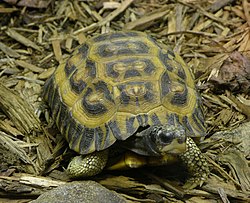| Flat-backed spider tortoise | |
|---|---|
 | |
| At the Philadelphia Zoo | |
| Scientific classification | |
| Kingdom: | Animalia |
| Phylum: | Chordata |
| Class: | Reptilia |
| Order: | Testudines |
| Suborder: | Cryptodira |
| Family: | Testudinidae |
| Genus: | Pyxis |
| Species: | P. planicauda |
| Binomial name | |
| Pyxis planicauda (Grandidier, 1867) | |
| Synonyms [3] | |
| |
The flat-backed spider tortoise (Pyxis planicauda), more commonly known as the flat-tailed tortoise, and Madagascan flat-tailed tortoise, is a tortoise that belongs to the family Testudinidae. [4] The various common names for this small tortoise usually refer to the noticeably flattened nature of its oblong upper-shell or its tail. [4]
Contents
The flat-backed spider tortoise is endemic to the west coast of Madagascar, between the Monrondava and Tsiribihina rivers. Due to the specifications of its habitat, the flat-backed spider tortoise is classified as critically endangered on the IUCN Red List. [4]

